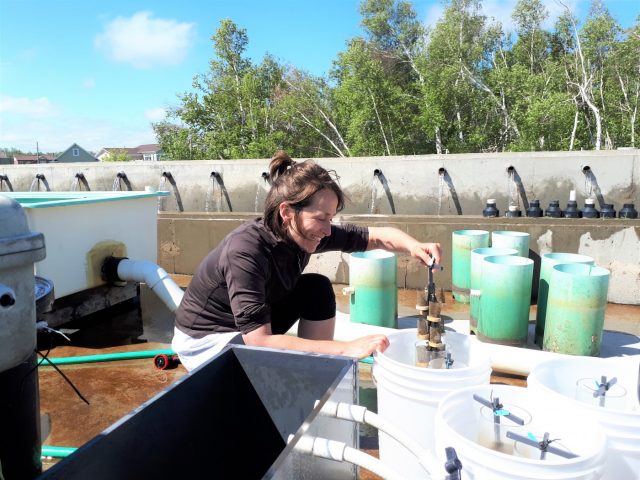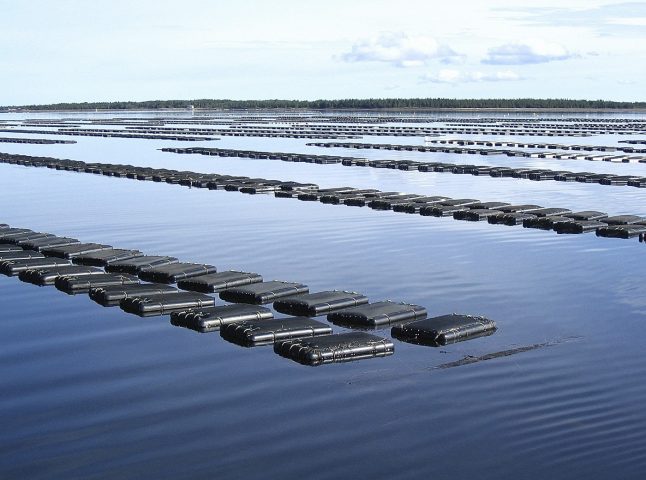The first article in a new series looking at the challenges facing oyster growers in New Brunswick
For many families, shucking and gulping down your first raw oyster is a celebrated right of passage in Maritimer life. The salty mollusks are also vital for the way of life in many small coastal communities in New Brunswick, employing nearly 500 people across the province.
But the times — and oceans — they are a’changing. And a new research program in northern New Brunswick is studying what these changes mean for the beloved eastern oyster.
Élise Mayrand, a biologist at the Université de Moncton’s Shippagan campus, is part of a team that looks at how the excessive production of carbon pollution (CO2) by people is changing the chemistry of coastal waters on the east coast and how these changes will affect the various life stages of eastern oysters.
Partners in the project include Martin Mallet, co-owner and manager of Etang Ruisseau Bar Ltd., and scientists with the Department of Fisheries and Oceans Canada.

What is ocean acidification?
Ocean acidification is one of the consequences of excessive CO2 production from human activities, namely the carbon pollution we emit when we burn fossil fuels such as coal, oil and gas.
Some of the CO2 we create is absorbed by the oceans, reacting with the water to form an unstable acid — carbonic acid. Excess levels of carbonic acid in the water does two things: it causes the water to become more acidic, and it unbalances the carbonate chemistry of our waters.
This means calcium carbonate — an important part of the outer shells, shells and skeletons of many marine organisms — is becoming less abundant in our oceans. As the oceans become more acidic, scientists say this will have a dramatic effect on some calcifying species’ ability to grow and thrive, including oysters, mussels, lobsters, sea urchins and some species of plankton.
Ocean acidification also causes physiological stress on organisms that must use more energy to cope with the changes happening around them. Scientists note that since the beginning of the Industrial Revolution, the acidity of the oceans has increased by 30 per cent.
While scientists have been monitoring acidification levels on the west coast of Canada for many years, very little study has taken place in the coastal waters of Atlantic Canada. Making this lack of east coast data even worse is the fact that local factors —such as freshwater inputs, eutrophication (the phenomenon of ‘nutrient loading’ in waters which causes oxygen levels in the water to decrease), and effluents discharged from industrial activities — can amplify and accelerate ocean acidification in certain areas.
What does this mean for eastern oysters?
Oyster aquaculture is an important industry for many coastal communities in New Brunswick. As noted above, nearly 500 people are directly employed by the industry, which sold 23 million oysters in 2016 at a farm gate value of $9.1 million.
The province’s new shellfish aquaculture development strategy, announced in 2017, aims to grow the industry by 10 per cent each year, rising to 30 million oysters sold and an economic contribution of $12 million in farm gate sales and $6.4 million in exports by 2021.

Unlike other forms of aquaculture in New Brunswick waters (such as salmon farming), oyster aquaculture has a low negative impact on the environment. In fact, oysters are filtering organisms that feed on phytoplankton, zooplankton, organic matter, and depend upon and contribute to a healthy marine environment.
Understanding how vulnerable the eastern oyster is to ocean acidification is vital for ensuring the mollusk remains an important part of both our coastal communities’ economies and a healthy marine ecosystem.
That’s where Mayrand and her team’s research comes into play. The group has profiled the acidity levels of three bays in northern New Brunswick (Saint Simon Bay, Caraquet Bay and Tracadie Bay), and found that, to date, acidity levels are generally within the range that eastern oysters can tolerate.
They did discover, however, periods of time where acidification reached problematic levels. According to experiments conducted under controlled conditions, larvae and juvenile oysters exposed to these levels of acidification need more energy to cope with this stress. This means young oysters would be left more vulnerable to a warming and more acidic ocean or outbreaks of disease.
This is troubling for researchers as the scientific community expects greater periods of increased acidification in eastern waters as carbon pollution emissions from human activity continues to rise and warm the oceans. The rise in ocean acidification, along with other “unprecedented and enduring changes” to the ocean and frozen parts of the planet, were documented in the Intergovernmental Panel on Climate Change’s latest report, released September 2019.
A unique opportunity to join the fight against ocean acidification
Mayrand will present her team’s findings in Shippagan in November. A conference for the public will take place on Nov. 13 and on Nov. 14, a forum will bring together stakeholders from the aquaculture and fisheries sectors, the relevant federal and provincial departments and environmental groups to discuss issues related to ocean acidification while exploring adaptation measures and solutions for limiting the rise in ocean acidity.
As part of this, young people will be given a unique opportunity to participate and express their concerns and solutions for slowing climate change and ocean acidification.
For more information on the forum, please contact Lisa Fauteux, Executive Director of the Verts Rivages environmental group. at (506)-888-5271.
